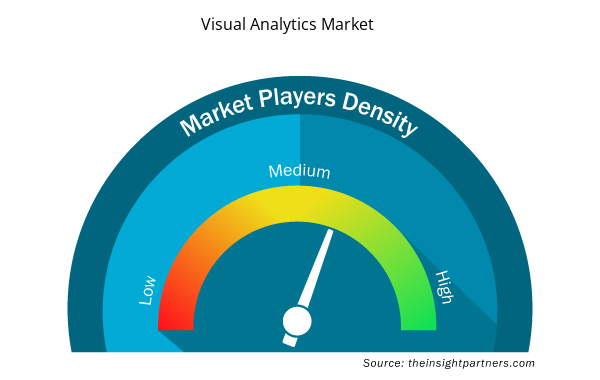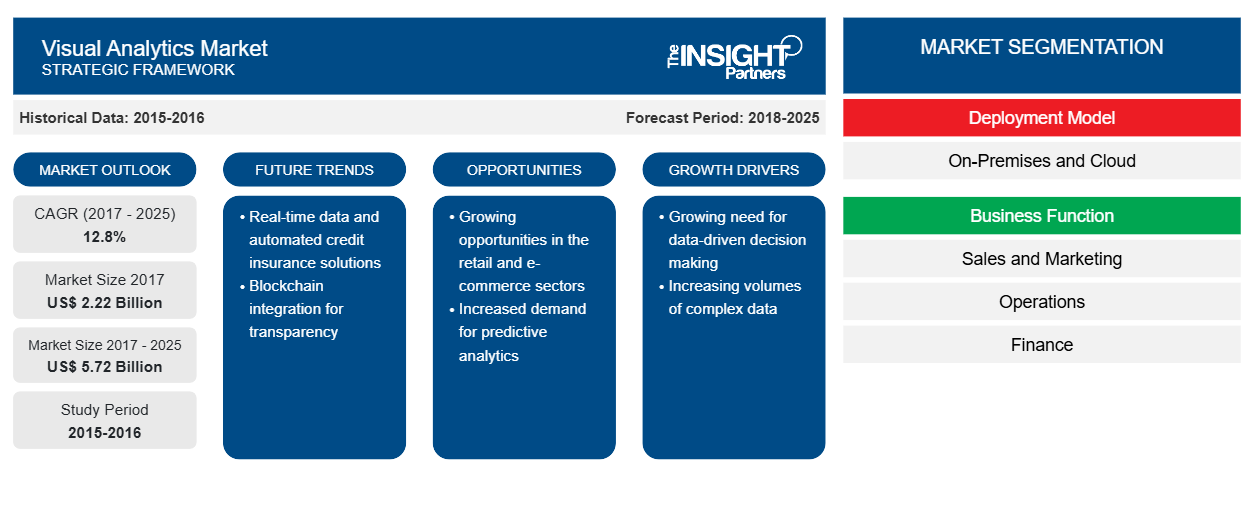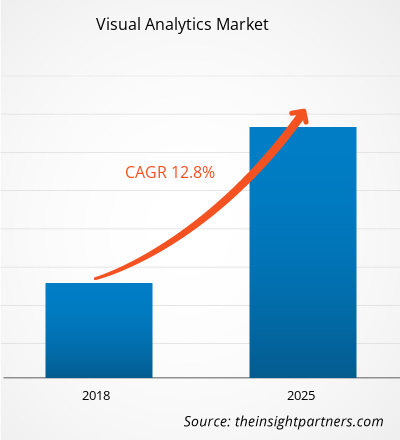[研究报告] 2017 年视觉分析市场价值为 22.15 亿美元,预计到 2025 年将达到 57.186 亿美元。预计在 2017 年至 2025 年的预测期内,视觉分析市场将以 12.8% 的复合年增长率增长。
将可视化与交互式分析相结合以探索大型数据集是可视化分析解决方案的根本目标。换句话说,可视化分析是通过交互式可视化界面促进分析推理的科学。更准确地说,可视化分析是一个迭代过程,涉及信息收集、数据预处理、知识表示、交互和决策。最终目标是深入了解手头的问题,该问题由来自异构来源的大量科学、法医或业务数据描述。为了实现这一目标,可视化分析将机器的优势与人类的优势相结合。一方面,数据库中的知识发现 (KDD)、统计学和数学方法是自动分析方面的驱动力,另一方面,人类感知、关联和总结的能力使可视化分析成为一个非常有前途的研究领域。如今,仅有数据可视化是不够的,公司期待着将数据驱动的分析功能与其数据可视化相结合。可视化分析可以解释为智力视觉隐喻的形成与手动信息交互相结合。
可视化分析市场已根据部署模式、业务功能和垂直细分。根据部署模式,可视化分析市场已细分为本地和云。根据业务功能,可视化分析市场已细分为销售和营销、运营、财务、供应链、信息技术、客户关系管理和人力资源。市场进一步根据垂直细分为零售和消费品、IT 和电信、BFSI、制造业、能源和公用事业、医疗保健和政府。从地理上看,市场分为五个区域,包括北美、欧洲、亚太地区、中东和非洲以及南美。
定制此报告以满足您的需求
您可以免费定制任何报告,包括本报告的部分内容、国家级分析、Excel 数据包,以及为初创企业和大学提供优惠和折扣
- 获取此报告的关键市场趋势。这个免费样品将包括数据分析,从市场趋势到估计和预测。
视觉分析市场洞察
全球人工智能和机器学习的普及程度
当今影响数据可视化和分析创新的最大趋势是人工智能 (AI) 和机器学习的普及。虽然对于不愿放弃人类控制的 IT 部门和分析师来说,这听起来可能很可怕,但包含 AI 和 ML 功能的分析平台实际上将成为现代分析师的高效助手。虽然人们可能会担心被取代,但机器学习实际上会增强分析师的能力,使他们更高效、更精确、对业务更有影响力。不要害怕机器学习技术,而是要抓住它带来的机遇。
基于部署模型的市场洞察
可视化分析包括云和本地部署模型。可视化分析的部署模型是决定选择特定模型的关键决策。企业根据各种因素更喜欢云和本地部署模式。许多中小企业都喜欢基于云的可视化分析,因为它价格低廉,是最佳部署类型。
基于业务功能的市场洞察
商业模式的转变导致全球各个垂直行业(尤其是发达地区)对将各种分析软件集成到业务流程中的需求不断增加。如今,业务用户已经摆脱了传统的数据管理、处理和分析技术。特定行业中的不同业务功能需要对数据进行分析以用于各种目的。
基于垂直行业的市场洞察
任何可视化分析工具的基本功能都是获取复杂数据,并以高度交互且易于理解的方式呈现给用户。可视化分析工具需要执行两项关键任务,包括数据可视化和数据分析。简单的可视化不足以解决简化大量数据的问题。这些工具的用户友好性、成本效益、可视化分析工具的自定义能力、交互式用户界面、仪表板和过滤选项是帮助最终用户决定为其业务功能选择特定可视化分析工具的一些参数。
视觉分析市场中的参与者专注于市场计划、收购和产品发布等策略,以保持其在视觉分析市场中的地位。视觉分析市场主要参与者的一些发展如下:
2018 年 9 月,TIBCO 为 TIBCO Spotfire 推出了 A(X) Experience,它将允许对数据流进行实时可视化分析,从而实现实时感知和采取行动。
2018 年 9 月,SAP SE 推出了 SAP Analytics Cloud,它是适用于所有分析的简单云。该分析云为客户提供数据可视化、预测和规划功能的一体化集成。
视觉分析市场区域洞察
Insight Partners 的分析师已详尽解释了预测期内影响可视化分析市场的区域趋势和因素。本节还讨论了北美、欧洲、亚太地区、中东和非洲以及南美和中美洲的可视化分析市场细分和地理位置。

- 获取可视化分析市场的区域特定数据
可视化分析市场报告范围
| 报告属性 | 细节 |
|---|---|
| 2017年市场规模 | 22.2亿美元 |
| 2025 年市场规模 | 57.2亿美元 |
| 全球复合年增长率(2017 - 2025) | 12.8% |
| 史料 | 2015-2016 |
| 预测期 | 2018-2025 |
| 涵盖的领域 | 按部署模型
|
| 覆盖地区和国家 | 北美
|
| 市场领导者和主要公司简介 |
|
市场参与者密度:了解其对商业动态的影响
可视化分析市场正在快速增长,这得益于终端用户需求的不断增长,而这些需求又源于消费者偏好的不断变化、技术进步以及对产品优势的认识不断提高等因素。随着需求的增加,企业正在扩大其产品范围,进行创新以满足消费者的需求,并利用新兴趋势,从而进一步推动市场增长。
市场参与者密度是指在特定市场或行业内运营的企业或公司的分布情况。它表明在给定市场空间中,相对于其规模或总市场价值,有多少竞争对手(市场参与者)存在。
在可视化分析市场运营的主要公司有:
- Tableau 软件
- 思爱普
- Qlik 技术
- TIBCO 软件
- ADVIZOR 解决方案私人有限公司
免责声明:上面列出的公司没有按照任何特定顺序排列。

- 获取可视化分析市场顶级关键参与者概览
可视化分析市场 – 按部署模型
- 本地部署
- 云
可视化分析市场 – 按业务功能
- 销售与营销
- 运营
- 金融
- 供应链
- 信息技术
- 客户关系管理
- 人力资源
- 其他的
可视化分析市场 – 垂直行业
- 零售及消费品市场
- 信息技术和电信
- 金融保险业协会
- 制造业
- 能源与公用事业
- 其他的
- 卫生保健
- 政府
可视化分析市场 – 按地区划分
北美
- 我们
- 加拿大
- 墨西哥
欧洲
- 法国
- 德国
- 西班牙
- 英国
- 意大利
亚太地区 (APAC)
- 中国
- 印度
- 日本
- 澳大利亚
中东及非洲
- 沙特阿拉伯
- 阿联酋
- 南非
山姆
- 巴西
可视化分析市场 – 公司简介
- ADVIZOR 解决方案有限公司
- Alteryx 公司
- IBM 公司
- 微策略公司
- 甲骨文公司
- QLIK 技术公司
- 聚合酶链反应
- SAS 研究所
- Tableau 软件
- TIBCO 软件公司
- 历史分析(2 年)、基准年、预测(7 年)及复合年增长率
- PEST 和 SWOT 分析
- 市场规模价值/数量 - 全球、区域、国家
- 行业和竞争格局
- Excel 数据集


- Dried Blueberry Market
- Artificial Intelligence in Healthcare Diagnosis Market
- Flexible Garden Hoses Market
- Social Employee Recognition System Market
- Piling Machines Market
- Skin Tightening Market
- USB Device Market
- Small Internal Combustion Engine Market
- Procedure Trays Market
- Data Center Cooling Market

Report Coverage
Revenue forecast, Company Analysis, Industry landscape, Growth factors, and Trends

Segment Covered
This text is related
to segments covered.

Regional Scope
North America, Europe, Asia Pacific, Middle East & Africa, South & Central America

Country Scope
This text is related
to country scope.
Trends and growth analysis reports related to Technology, Media and Telecommunications : READ MORE..
The List of Companies
1. Tableau Software
2. SAP SE
3. Qlik Technologies
4. TIBCO Software
5. ADVIZOR Solutions Pvt. Ltd
6. SAS Institute
7. Oracle Corporation
8. MicroStrategy
9. IBM Corporation
10. Alteryx, Inc.
The Insight Partners performs research in 4 major stages: Data Collection & Secondary Research, Primary Research, Data Analysis and Data Triangulation & Final Review.
- Data Collection and Secondary Research:
As a market research and consulting firm operating from a decade, we have published and advised several client across the globe. First step for any study will start with an assessment of currently available data and insights from existing reports. Further, historical and current market information is collected from Investor Presentations, Annual Reports, SEC Filings, etc., and other information related to company’s performance and market positioning are gathered from Paid Databases (Factiva, Hoovers, and Reuters) and various other publications available in public domain.
Several associations trade associates, technical forums, institutes, societies and organization are accessed to gain technical as well as market related insights through their publications such as research papers, blogs and press releases related to the studies are referred to get cues about the market. Further, white papers, journals, magazines, and other news articles published in last 3 years are scrutinized and analyzed to understand the current market trends.
- Primary Research:
The primarily interview analysis comprise of data obtained from industry participants interview and answers to survey questions gathered by in-house primary team.
For primary research, interviews are conducted with industry experts/CEOs/Marketing Managers/VPs/Subject Matter Experts from both demand and supply side to get a 360-degree view of the market. The primary team conducts several interviews based on the complexity of the markets to understand the various market trends and dynamics which makes research more credible and precise.
A typical research interview fulfils the following functions:
- Provides first-hand information on the market size, market trends, growth trends, competitive landscape, and outlook
- Validates and strengthens in-house secondary research findings
- Develops the analysis team’s expertise and market understanding
Primary research involves email interactions and telephone interviews for each market, category, segment, and sub-segment across geographies. The participants who typically take part in such a process include, but are not limited to:
- Industry participants: VPs, business development managers, market intelligence managers and national sales managers
- Outside experts: Valuation experts, research analysts and key opinion leaders specializing in the electronics and semiconductor industry.
Below is the breakup of our primary respondents by company, designation, and region:

Once we receive the confirmation from primary research sources or primary respondents, we finalize the base year market estimation and forecast the data as per the macroeconomic and microeconomic factors assessed during data collection.
- Data Analysis:
Once data is validated through both secondary as well as primary respondents, we finalize the market estimations by hypothesis formulation and factor analysis at regional and country level.
- Macro-Economic Factor Analysis:
We analyse macroeconomic indicators such the gross domestic product (GDP), increase in the demand for goods and services across industries, technological advancement, regional economic growth, governmental policies, the influence of COVID-19, PEST analysis, and other aspects. This analysis aids in setting benchmarks for various nations/regions and approximating market splits. Additionally, the general trend of the aforementioned components aid in determining the market's development possibilities.
- Country Level Data:
Various factors that are especially aligned to the country are taken into account to determine the market size for a certain area and country, including the presence of vendors, such as headquarters and offices, the country's GDP, demand patterns, and industry growth. To comprehend the market dynamics for the nation, a number of growth variables, inhibitors, application areas, and current market trends are researched. The aforementioned elements aid in determining the country's overall market's growth potential.
- Company Profile:
The “Table of Contents” is formulated by listing and analyzing more than 25 - 30 companies operating in the market ecosystem across geographies. However, we profile only 10 companies as a standard practice in our syndicate reports. These 10 companies comprise leading, emerging, and regional players. Nonetheless, our analysis is not restricted to the 10 listed companies, we also analyze other companies present in the market to develop a holistic view and understand the prevailing trends. The “Company Profiles” section in the report covers key facts, business description, products & services, financial information, SWOT analysis, and key developments. The financial information presented is extracted from the annual reports and official documents of the publicly listed companies. Upon collecting the information for the sections of respective companies, we verify them via various primary sources and then compile the data in respective company profiles. The company level information helps us in deriving the base number as well as in forecasting the market size.
- Developing Base Number:
Aggregation of sales statistics (2020-2022) and macro-economic factor, and other secondary and primary research insights are utilized to arrive at base number and related market shares for 2022. The data gaps are identified in this step and relevant market data is analyzed, collected from paid primary interviews or databases. On finalizing the base year market size, forecasts are developed on the basis of macro-economic, industry and market growth factors and company level analysis.
- Data Triangulation and Final Review:
The market findings and base year market size calculations are validated from supply as well as demand side. Demand side validations are based on macro-economic factor analysis and benchmarks for respective regions and countries. In case of supply side validations, revenues of major companies are estimated (in case not available) based on industry benchmark, approximate number of employees, product portfolio, and primary interviews revenues are gathered. Further revenue from target product/service segment is assessed to avoid overshooting of market statistics. In case of heavy deviations between supply and demand side values, all thes steps are repeated to achieve synchronization.
We follow an iterative model, wherein we share our research findings with Subject Matter Experts (SME’s) and Key Opinion Leaders (KOLs) until consensus view of the market is not formulated – this model negates any drastic deviation in the opinions of experts. Only validated and universally acceptable research findings are quoted in our reports.
We have important check points that we use to validate our research findings – which we call – data triangulation, where we validate the information, we generate from secondary sources with primary interviews and then we re-validate with our internal data bases and Subject matter experts. This comprehensive model enables us to deliver high quality, reliable data in shortest possible time.


 获取此报告的免费样本
获取此报告的免费样本